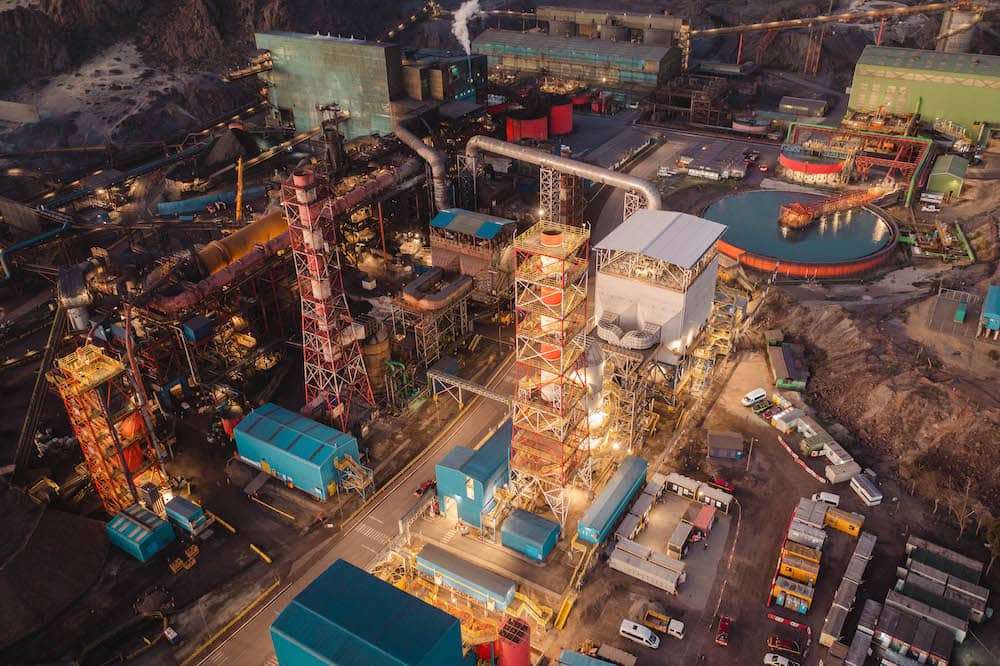Pellet Plant celebrates its 45th anniversary, outlining new challenges

March 15, 1978 was a historic day for the port town of Huasco and its people. On that Wednesday, Compañía Minera del Pacífico’s (CMP) Guacolda II Pellet Plant and Port was officially inaugurated, becoming the main source of jobs and economic growth in the area.
The construction of the Pellet Plant, catalogued at the time as the second largest of its kind in the world, involved the participation of more than three thousand workers, Americans, Japanese and, mostly, Chileans, who came up with ingenious initiatives to assemble the Dantesque structures.
With the plant and port operating, with a nominal production capacity of 3.5 million tons per year, the continuity of Minas El Algarrobo was assured, another historic CMP site in the Huasco Valley, where thousands of families, directly and indirectly linked to the company, established networks of support and affection that have transcended generations.
In recent years, as part of CMP’s strategy to promote a different kind of mining, a work plan has been implemented to contribute to continue supplying quality iron to the national and international steel industry, taking into account the most modern and demanding environmental standards.
“We are committed to facing the challenges of the future, listening to the community and incorporating technologies that improve our processes, to continue walking together with workers, employees and neighbors towards a sustainable mining activity that continues to add value to the territory,” says Marcos Sarmiento, assistant manager of CMP Valle del Huasco Operations.
He added that work is being done to reduce emissions with initiatives such as the total decarbonization of the Pellet Plant, which is now operating with natural gas; the installation of a second electrostatic precipitator to reduce particulate matter; reviewing and improving the entire process to minimize the emission of dust into the environment at the sites and in rail transport from Mina Los Colorados; and the increasing introduction of 100% electric vehicles, such as buses, shovels and trucks.
In addition, the Filtered Tailings Deposit (DRF) is being built, the only one of its kind in the iron ore mining industry in the country, which will dispose of these wastes in a sustainable and innovative way to the south of the Pellet Plant. This project includes the development of a new landscape rehabilitation methodology for the progressive closure of the deposit, as its terraces are filled. It should be noted that this initiative is being promoted with the advice of Pontificia Universidad Católica de Chile, Pontificia Universidad Católica de Valparaíso, Universidad de Santiago de Chile and Universidad de Atacama.
CMP is also making progress in actions that allow it to use water more efficiently in the development of its operations. In this regard, it currently consumes 33% less than the average for the country’s mining companies, and 2024 it seeks to reduce fresh water consumption by a further 30%.
We are also working to strengthen alliances with various stakeholders, encouraging business ideas from entrepreneurs and micro-entrepreneurs in the territory; promoting conditions for the inclusion of more local workers; and promoting citizen participation and dialogue to build, together with the Huasca community, a shared growth.
“For more than four decades, we have been working every day to improve our operations and the quality of life in the Huasco district, where we are developing an investment and project plan to help us meet the productive, environmental and social challenges of the area. The advances we are implementing today at the Pellet Plant and Puerto Guacolda II are proof of CMP’s commitment to the territory and its people, with a view to promoting a different kind of mining that will enable us to achieve the best standards of sustainability”, concludes Marcos Sarmiento.
 Copiapó Valley
Copiapó Valley  Cerro Negro Norte Mine
Cerro Negro Norte Mine  Magnetite Plant
Magnetite Plant  Puerto Punta Totoralillo
Puerto Punta Totoralillo  Huasco Valley
Huasco Valley  Los Colorados Mine
Los Colorados Mine  Pellets Plant
Pellets Plant  Puerto Guacolda II
Puerto Guacolda II  Elqui Valley
Elqui Valley  El Romeral Mines
El Romeral Mines  Pleito Mine
Pleito Mine  Puerto Guayacán
Puerto Guayacán